The Growth Path of Agricultural Labor Productivity in China: A Latent Growth Curve Model at the Prefectural Level †
Abstract
:1. Introduction
2. Methodology and Data
2.1. Latent Growth Curve Modeling
2.2. The Dataset: China’s Agricultural Labor Productivity 2000–2013
2.3. LGCM Processing
3. Results: China’s Trajectory of Agricultural Labor Productivity
3.1. The Estimation of Unspecific LGCMs
3.2. The Estimation of the Piecewise Model
3.3. The Convergence Estimation of China’s Agricultural Labor Productivity
4. Discussions
4.1. The Breaking Year of 2004
4.2. The Breaking Point of 2008
4.3. Mapping China on Regional Disparities of Agricultural Labor Productivity
5. Conclusions
Acknowledgments
Author Contributions
Conflicts of Interest
Appendix
Appendix A. Changes of Agricultural Output and Inputs in China (1990–2013)
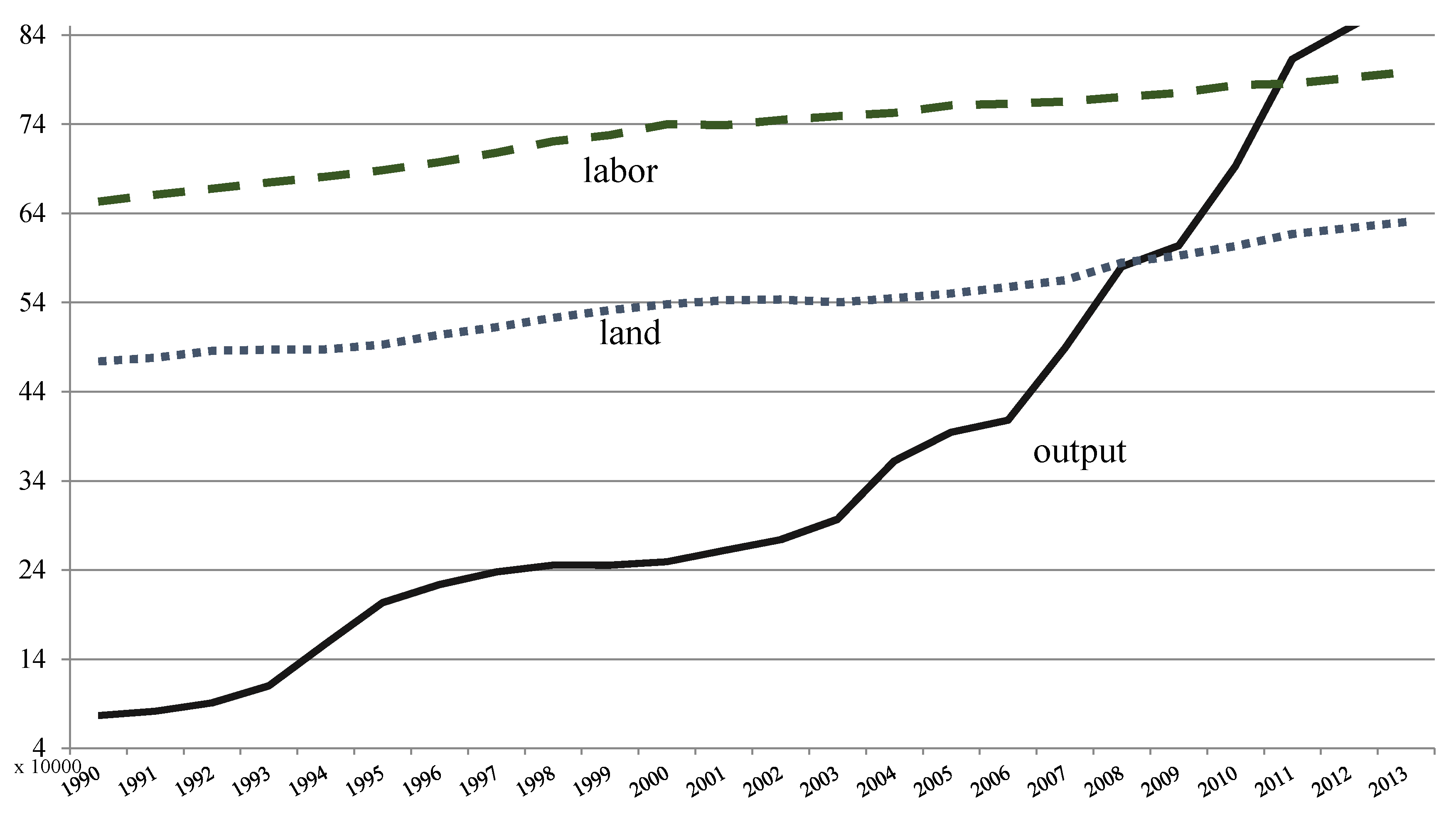
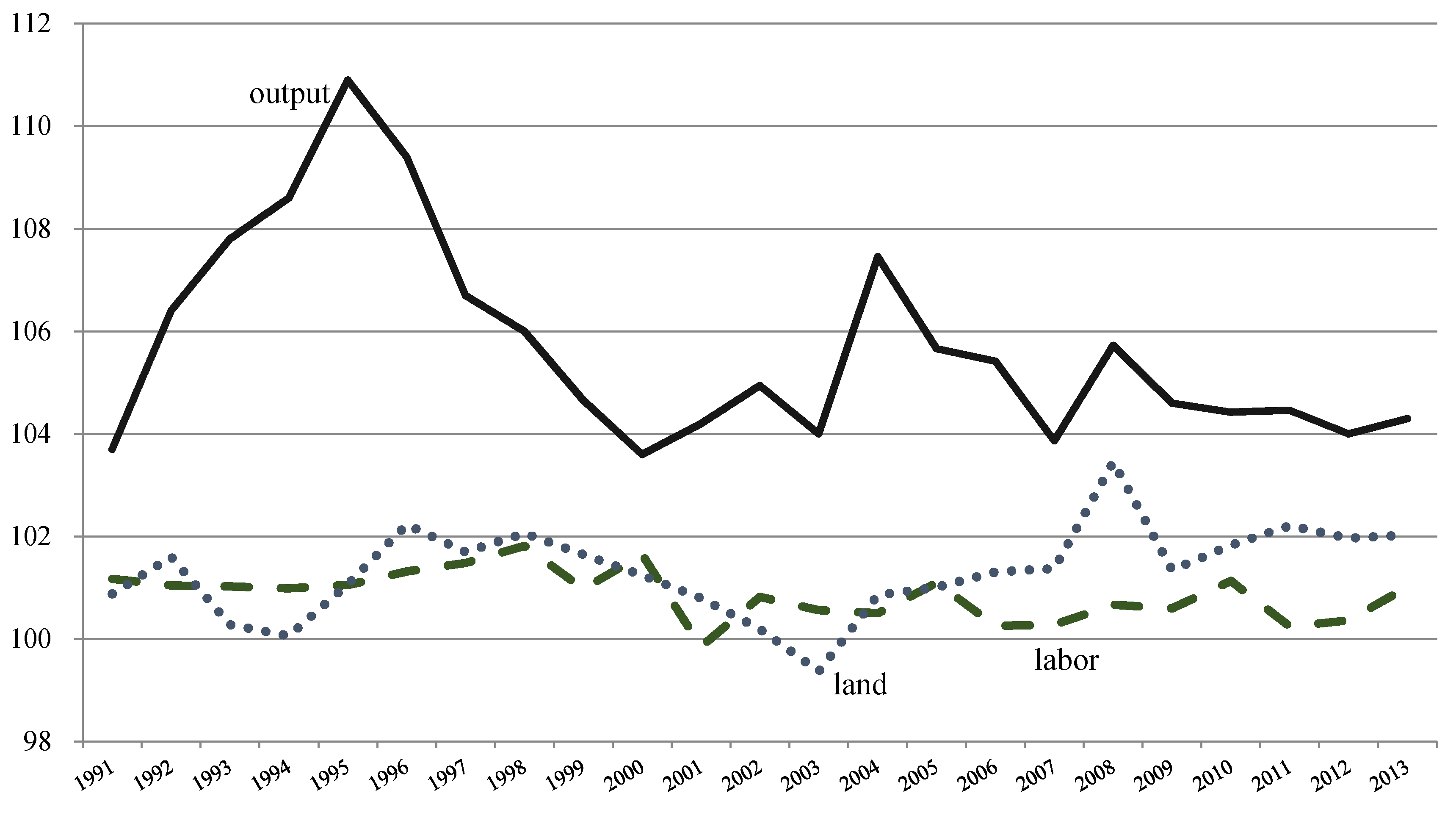
Appendix B. The Modification Indices Suggest to Add an Error Covariance
| Year_1 | Year_2 | Decrease in Chi-square | New Estimate |
|---|---|---|---|
| AP04 | AP03 | 281.1 | 87.97 |
| AP09 | AP06 | 105.3 | −119 |
| AP09 | AP08 | 120.8 | 231.96 |
| AP10 | AP08 | 123.2 | 259.73 |
| AP10 | AP09 | 216.6 | 672.01 |
| AP11 | AP09 | 163.9 | 679.26 |
| AP11 | AP10 | 157.3 | 715.82 |
Appendix C. Convergence Estimation
Appendix D. Chinese Map of Administrative Districts

References
- S. Fan. “Production and productivity growth in Chinese agriculture: New measurement and evidence.” Food Policy 22 (1997): 213–228. [Google Scholar] [CrossRef]
- K.H. Cao, and J.A. Birchenall. “Erratum to “Agricultural Productivity, Structural Change, and Economic Growth in Post-Reform China” [J. Dev. Econ., Volume 104, September 2013, pp. 165–180].” J. Dev. Econ. 106 (2014): 107. [Google Scholar] [CrossRef]
- K. Cao, and J.A. Birchenall. “Agricultural Productivity, Structural Change, and Economic Growth in Post-reform China.” J. Dev. Econ. 104 (2013): 165–180. [Google Scholar] [CrossRef]
- S.L. Wang, F. Tuan, F. Gale, A. Somwaru, and J. Hansen. “China’s regional agricultural productivity growth in 1985–2007: A multilateral comparison.” Agric. Econ. 44 (2013): 241–251. [Google Scholar] [CrossRef]
- S. Rozelle, J.E. Taylor, and A. Debrauw. “Migration, remittances, and agricultural productivity in China.” Am. Econ. Rev. 89 (1999): 287–291. [Google Scholar] [CrossRef]
- D. Gollin, S. Parente, and R. Rogerson. “The Role of Agriculture in Development.” Am. Econ. Rev. 92 (2002): 160–164. [Google Scholar] [CrossRef]
- D. Gollin, D. Lagakos, and M.E. Waugh. “The agricultural productivity gap.” Q. J. Econ. 129 (2014): 939–993. [Google Scholar] [CrossRef]
- D. Gollin, D. Lagakos, and M.E. Waugh. “Agricultural Productivity Differences across Countries.” Am. Econ. Rev. 104 (2014): 165–170. [Google Scholar] [CrossRef]
- NDRC Reveals Details of Stimulus Package. China Daily. 27 November 2008. Available online: http://www.chinadaily.com.cn/bizchina/2008-11/27/content_7246758.htm (accessed on 11 April 2016).
- Y. Lin. “Rural reform and agricultural growth in China.” Am. Econ. Rev. 82 (1992): 34–51. [Google Scholar]
- J. Huang, R. Hu, and S. Rozelle. “China’s agricultural research system and reforms: Challenges and implications to the developing countries.” Asian J. Agric. Dev. 1 (2004): 107–123. [Google Scholar]
- H.F. Gale, L. Bryan, and F.C. Tuan. “China’s New Farm Subsidies.” 2005. Available online: http://ssrn.com/abstract=759444 (accessed on 19 March 2013 ).
- J. Huang, X. Wang, H. Zhi, Z. Huang, and S. Rozelle. “Subsidies and distortions in China’s agriculture: Evidence from producer-level data.” Aust. J. Agric. Resour. Econ. 55 (2011): 53–71. [Google Scholar] [CrossRef]
- S. Jin, H. Ma, J. Huang, R. Hu, and S. Rozelle. “Productivity, efficiency and technical change: Measuring the performance of China’s transforming agriculture.” J. Prod. Ana. 33 (2010): 191–207. [Google Scholar] [CrossRef]
- China and Global Farming—The Wrong Direction. The Economist. 16 May 2015. Available online: http://www.economist.com/news/china/21651272-others-cut-farm-support-china-spends-more-wrong-direction (accessed on 11 April 2016).
- K.J. Preacher. “Latent Growth Curve Models.” In The Reviewer’s Guide to Quantitative Methods in the Social Sciences. Edited by G.R. Hancock and R. Mueller. New York, NY, USA: Taylor and Francis, 2010. [Google Scholar]
- T.A. Brown. Confirmatory Factor Analysis for Applied Research. New York, NY, USA: The Guildford Press, 2006. [Google Scholar]
- G.R. Hancock, and F.R. Lawrence. “Using Latent Growth Models to evaluate longitudinal change.” In Structural Equation Modeling: A Second Course. Edited by G.R. Hancock and R.O. Mueller. Greenwich, UK: Information Age Publishing, 2006. [Google Scholar]
- K.A. Bollen, and P. Curran. Latent Curve Models: A Structural Equation Perspective. Hoboken, NJ, USA: Wiley Series in Probability and Statistics, 2006. [Google Scholar]
- A. Satorra, and P.M. Bentler. “A scaled difference chi-square test statistic for moment structure analysis.” Psychometrika 66 (2001): 507–514. [Google Scholar] [CrossRef]
- Chinese City Statistical Yearbooks. Beijing, China: China Statistics Press, 2001–2014.
- L. Hu, and P.M. Bentler. “Cut off criteria for fit indexes in covariance structure analysis: Conventional criteria versus new alternatives.” Struct. Equ. Model. 6 (1999): 1–55. [Google Scholar] [CrossRef]
- M.W. Browne, and R. Cudeck. “Alternative ways of assessing model fit.” In Testing Structural Equation Models. Edited by K.A. Bollen and J.S. Long. Newbury Park, CA, USA: Sage, 1993. [Google Scholar]
- G.R. Hancock, and J. Choi. “A vernacular for Linear Latent Growth Models.” Struct. Equ. Model. 13 (2006): 352–377. [Google Scholar] [CrossRef]
- W.J. Baumol. “Productivity Growth, Convergence, and Welfare: What the Long-run Data Show.” Am. Econ. Rev. 76 (1986): 1072–1085. [Google Scholar]
- R.J. Barro. “Economic growth in a cross section of countries.” Q. J. Econ. 106 (1991): 407–443. [Google Scholar] [CrossRef]
- R.J. Barro, and X. Sala-i-Martin. “Convergence.” J. Polit. Econ. 100 (1991): 223–251. [Google Scholar] [CrossRef]
- R.J. Barro, and X. Sala-i-Martin. Economic Growth. Cambridge, MA, USA: MIT Press, 1995. [Google Scholar]
- X. Sala-i-Martin. “The classical approach to convergence analysis.” Econ. J. 106 (1996): 1019–1036. [Google Scholar] [CrossRef]
- X. Sala-i-Martin. “Regional cohesion: Evidence and theories of regional growth and convergence.” Eur. Econ. Rev. 40 (1996): 1325–1352. [Google Scholar] [CrossRef]
- G.E. Boyle, and T.G. McCarthy. “Simple measures of convergence in per capita GDP: A note on some further international evidence.” Appl. Econ. Lett. 6 (1999): 343–347. [Google Scholar] [CrossRef]
- D. Furceri. “β and σ-Convergence: A Mathematical Relation of Causality.” Econ. Lett. 89 (2005): 212–215. [Google Scholar] [CrossRef]
- X.X. Sala-i-Martin. “Regional Cohesion: Evidence and Theories of Regional Growth and Convergence.” Eur. Econ. Rev. 40 (1996): 1325–1352. [Google Scholar] [CrossRef]
- R.J. Barro, and X.X. Sala-i-Martin. “Convergence.” J. Political Econ. 100 (1992): 223–251. [Google Scholar] [CrossRef]
- C. Guo, and G. Zhao. “Evaluation the efficiency of food direct subsidy policy in China based on institutional economics.” Chin. Agric. Mech. 4 (2010): 91–93. [Google Scholar]
- C. Li. “Analyzing the reform of agricultural subsidy policies in China from the viewpoint of sustainable development system.” Territ. Nat. Resour. Study 4 (2007): 33–35. [Google Scholar]
- Y. Du. “The review and reflection of Chinese new agricultural subsidy system.” J. Polit. Law 4 (2011): 132–137. [Google Scholar] [CrossRef]
- F. Cai. “Demographic transition, demographic dividend, and Lewis Turning Point in China.” China Econ. J. 3 (2010): 107–119. [Google Scholar] [CrossRef]
- B.M. Flesher, R. Fearn, and Z. Ye. “The Lewis model applied to China: Editorial introduction to the symposium.” China Econ. Rev. 22 (2011): 535–541. [Google Scholar] [CrossRef]
- X. Zhang, J. Yang, and S. Wang. “China has reached the Lewis turning point.” China Econ. Rev. 22 (2011): 542–554. [Google Scholar] [CrossRef]
- S. Fardoust, J.Y. Lin, and X. Luo. “Demystifying China’s Fiscal Stimulus. World Bank Policy Research Working Paper No. 6221.” 2012. Available online: http://ssrn.com/abstract=2160191 (accessed on 19 March 2013).
- C. Wong. “The Fiscal Stimulus Programme and Public Governance Issues in China.” OECD J. Budg. 11 (2011): 1–21. [Google Scholar] [CrossRef]
- B. Naughton. “Understanding the Chinese Stimulus Package.” China Leadership Monitor. 2009. Available online: http://www.hoover.org/sites/default/files/uploads/documents/CLM28BN.pdf (accessed on 21 March 2013).
- P. Bin, R. Fanfani, and C. Brasili. “Regional differences and dynamic changes in rural China: The study of 1996 and 2006 National Agricultural Census.” Asian J. Agric. Rural Dev. 2 (2012): 260–270. [Google Scholar]
- Chinese City Statistical Yearbooks. Beijing, China: China Statistics Press, 1991–2014.
- 1The increase in grain production during 2004 was due primarily to a 30-percent increase in grain prices.
- 2The China City Statistical Yearbook reflects the socioeconomic conditions of the main prefectural cities (or provincial cities) in China. Here, the city is a definition of administrative zoning, a prefectural level, rather than the urban areas. Autonomous prefectures are excluded in this yearbook.
- 3We use the output and employment data of macro agriculture, the first sector, as a proxy to agriculture, since they are the only available data at this level to calculate agricultural labor productivity.
- 4In order to keep the authenticity of the original data, we delete five samples with missing data and three outliers (Qingyang, Hengyang and Zhongshan), which were only 8 out of 287 initial observations. Tibet was deleted because of the missing values.
- 5The project of “4-Trillion-Yuan Stimulus Package” (US$586 billion) is firstly proposed by the Chinese government in November 2008, and the formal implementation is in 2009, when the State Council has issued ten measures to expand domestic demand.
- 6The decreasing in chi-square is higher than the one between AP09 and AP11 (see Appendix B).
- 8This rescaled value of initial average level of agricultural labor productivity is closer to the actual mean value (832,464 Yuan) in 2000, compared with the previous overestimated initial level 905,000 Yuan in the unspecific model, indicating a better goodness-of-fit of the piecewise model to some extent.
- 9The Relative Gradient (RG) is a measure of the general inclination or tilt of the trajectories. It is the ratio of mean and standard deviation (Hancock and Choi, 2006 [18]). For a non-central standard normal distribution N (RG, 1), the expected proportion above 0 will be: (a) RG (β1) = 0.42, normal distribution probability = 0.6628, thus 66.28% of the estimated slopes β1 are positive and 33.72% are negative; (b) RG (β2) = 0.58, normal distribution probability = 0.7199, thus 72.24% of the estimated slopes β2 are positive and 28.01% are negative; (c) RG (β3) = 0.75, normal distribution probability = 0.7730, thus 77.30% of the estimated slopes β3 are positive and 22.70% are negative.
- 10The elaboration of σ-convergence and β-convergence is omitted here for the sake of brevity (please see Sala-i-Martin (1996) [33] and Barro and Sala-i-Martin (1992) [34] for a reference). The measuring functions are presented in Appendix C.
- 11In early 2002, the State Council issued the “No. 2 Document of 2002”, setting out four principles for labor migration: fair treatment, reasonable guidance, improved management and better services. In 2003, the “No. 1 Document” of the State Council Office drew from these four principles the commitments of abolishing unfair restrictions on rural labors seeking for temporary or permanent employment in urban areas and providing more guaranties in law contracts of payment and healthcare, living conditions, education for their children and training programs. In 2004, a document on the improvement of health services, the prevention of work-related illness and the provision of the treatment of work-related illness among migrant workers was issued, and later in that year, a further document underscoring the necessity for work-injury insurance for migrant laborers was issued to be provided by employers and enterprises, especially in high risk industries, such as construction, mining, etc.
- 12The agricultural output has been increasing in aggregate during this new decade, which we have already shown in Figure 1. As far as we are concerned, it may be attributed to the TFP: the continuous improvements of agro science and technology further drive up agricultural production. Interestingly, this viewpoint can also be connected with the first potential factor of agro policy reform. Owing to the Chinese government attaching higher importance to agriculture in the guideline of the new decade, large investments had been put into research and development and, therefore, created a series of breakthroughs in agro science and technology.
- 13The experimental reform of the agricultural tax reform started in 2002, covering Hebei, Inner Mongolia, Heilongjiang, Jilin, Jiangxi, Shandong, Henan, Hubei, Hunan, Chongqing, Sichuan, Guizhou, Shaanxi, Gansu, Qinghai and Ningxia as pilots, according to their own governmental finances and agriculture conditions; the experimental reform of the direct subsidy for grain also started in 2002, covering Anhui, Jilin, Hunan, Hubei, Henan, Liaoning, Inner Mongolia, Jiangxi and Hebei, the nine main grain production areas, as pilots. As we checked, most of the prefectures in these regions indeed grew at a relatively faster rate after the formal enactment of the agricultural reform.
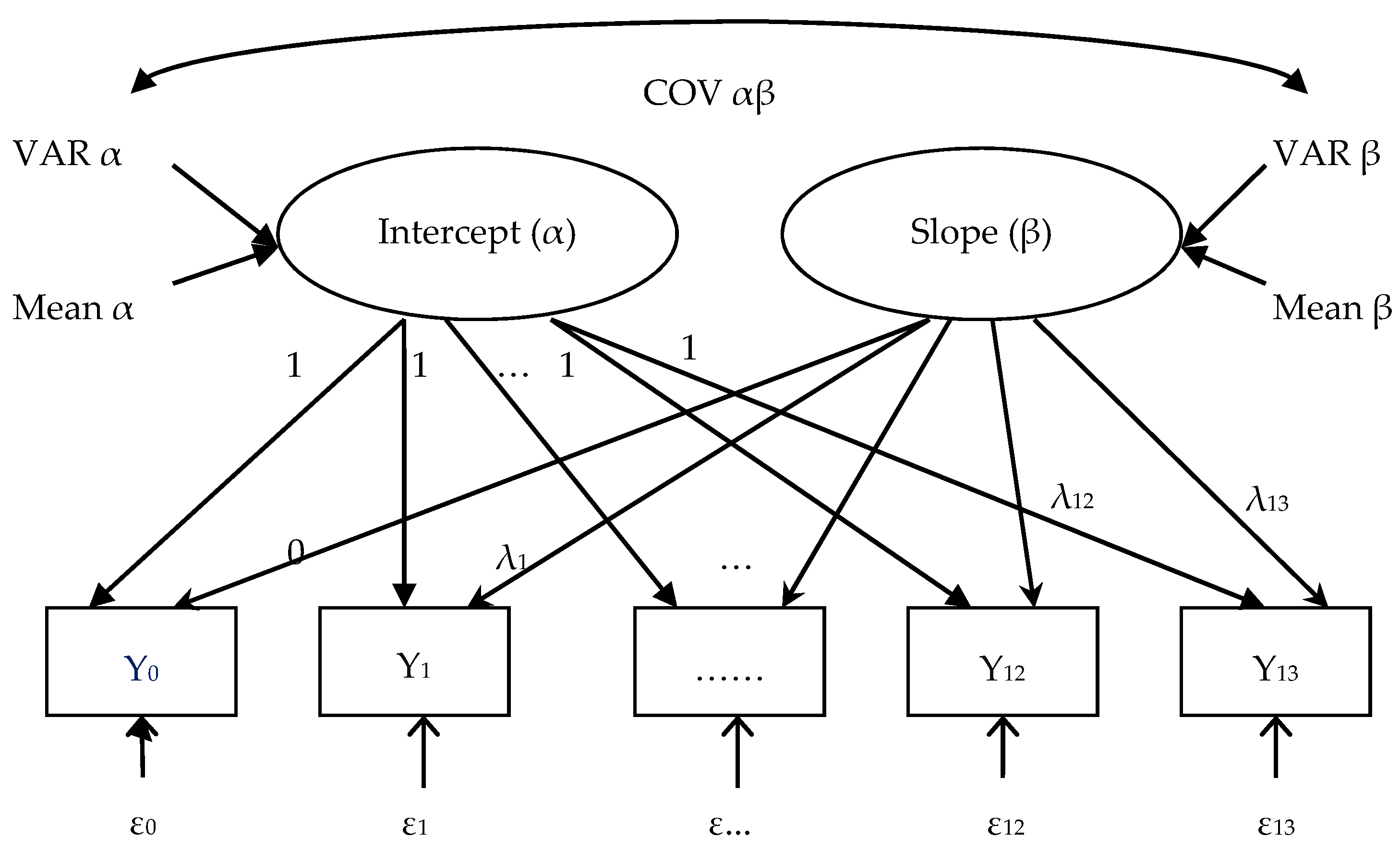
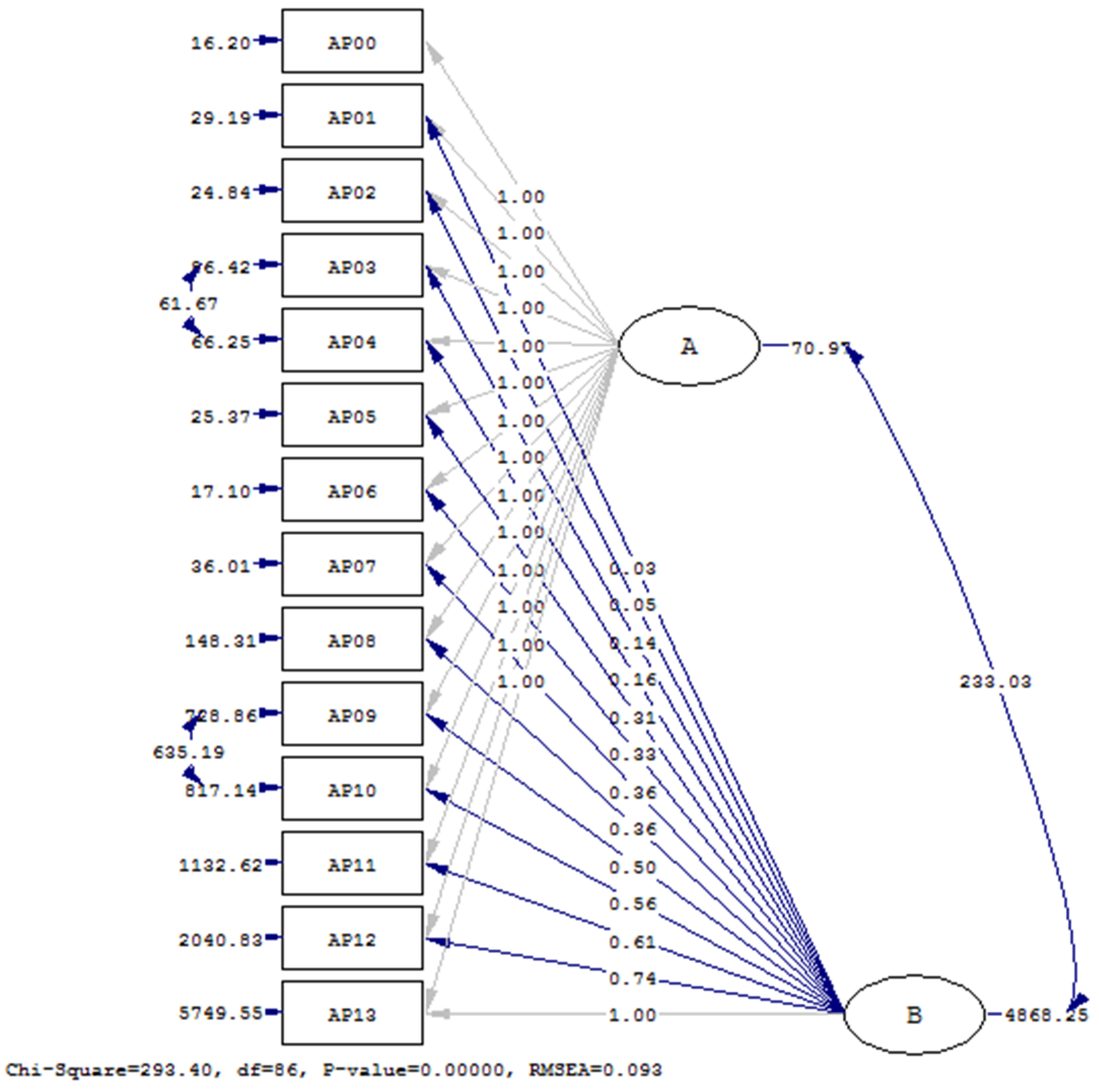
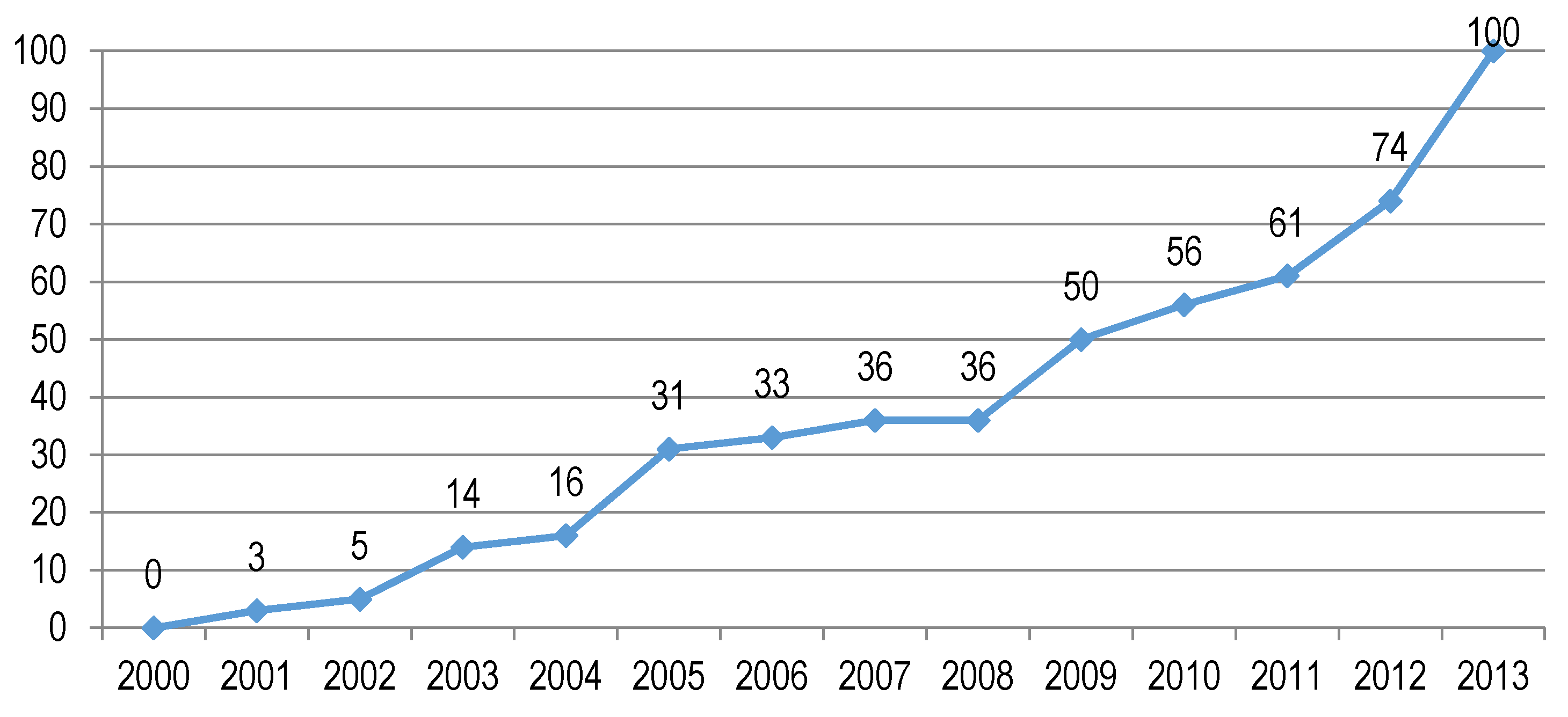
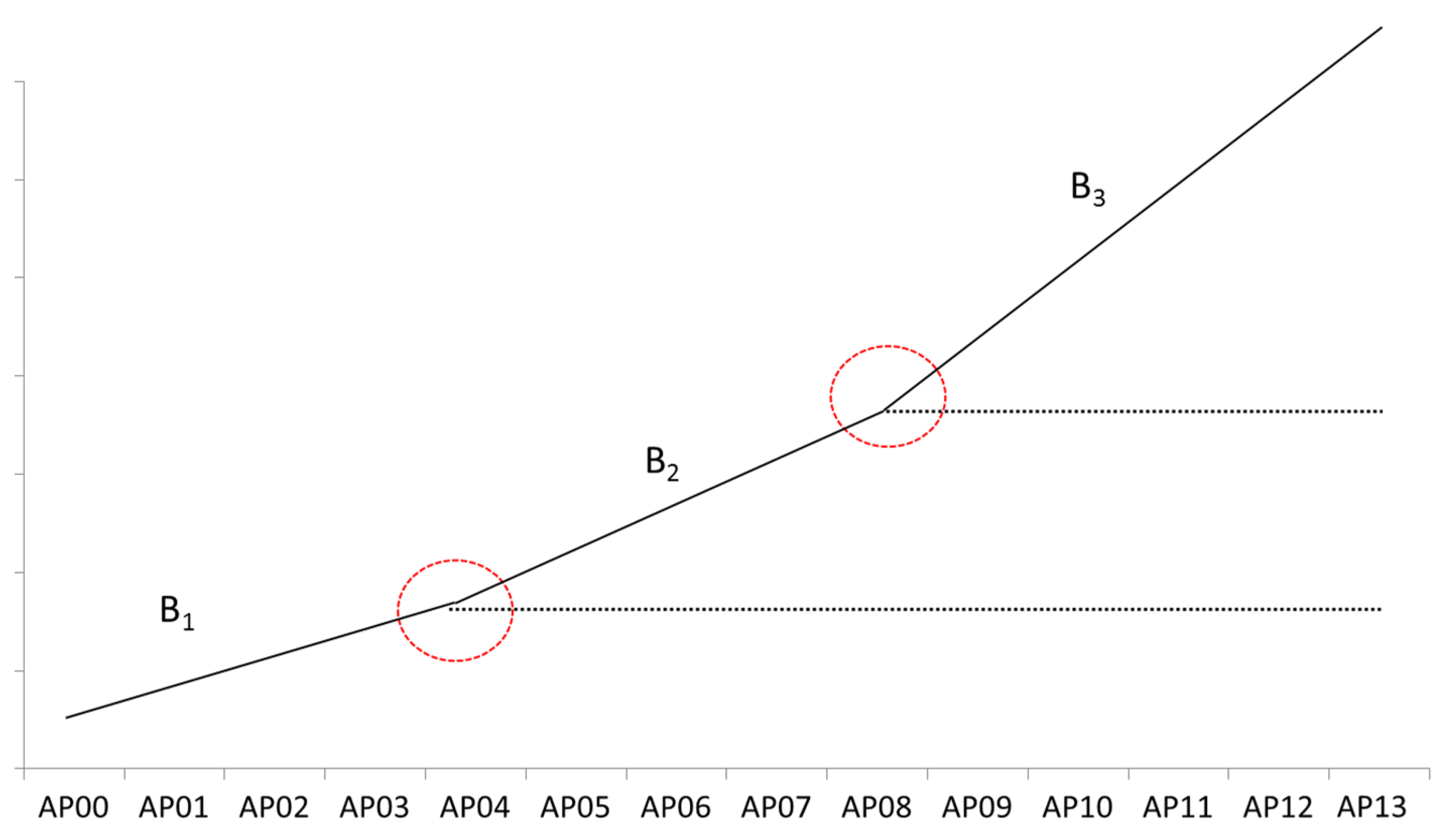
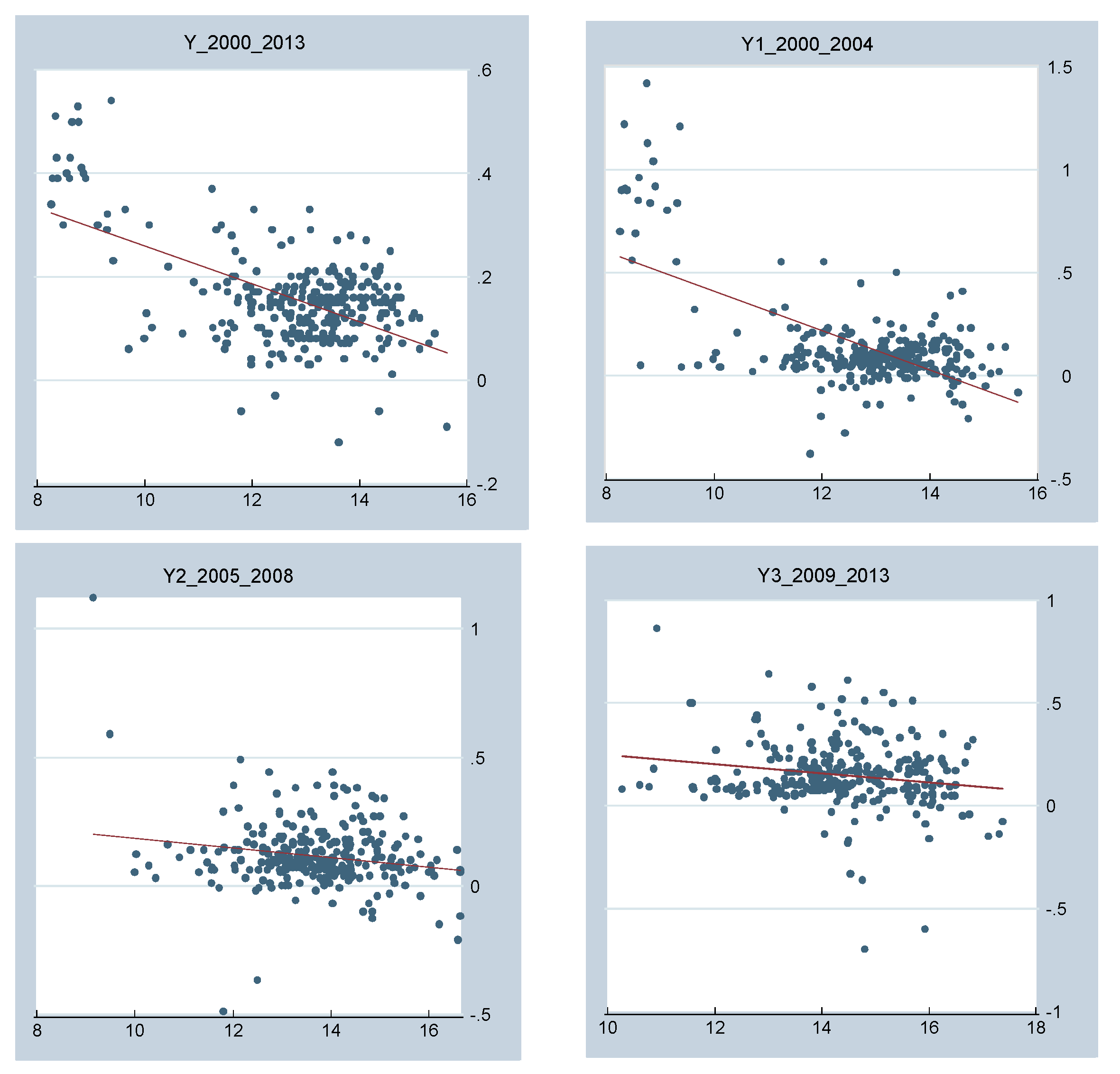
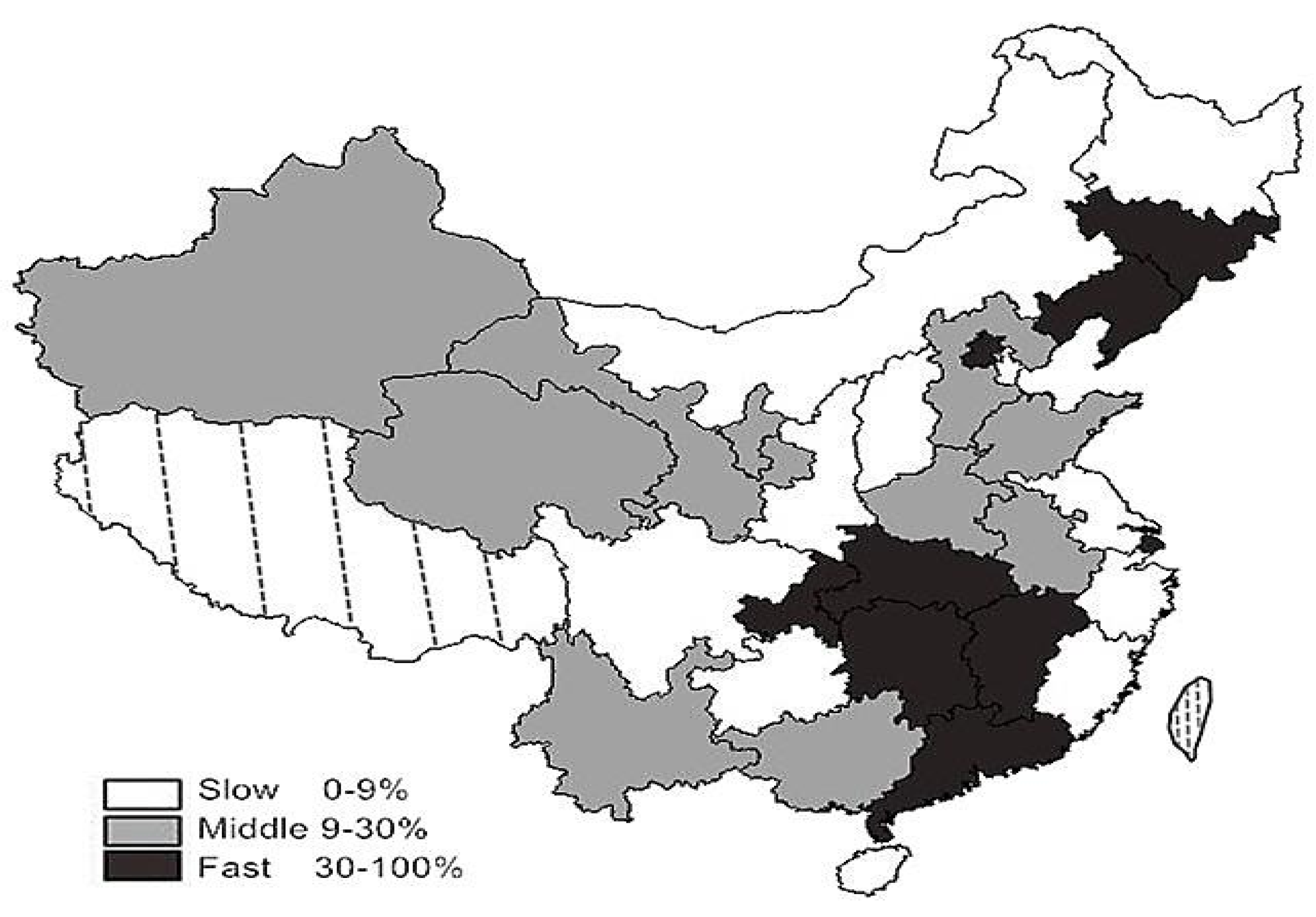
| Parameter | Variances | Covariance | Correlation | Means | ||
|---|---|---|---|---|---|---|
| Var (α) | Var (β) | Cov (α, β) | Corr (α, β) | μ (α) | μ (β) | |
| Estimate | 70.97 | 4868.25 | 233.03 | 0.40 | 7.62 | 37.71 |
| t-values | 4.26 | 3.68 | 3.42 | 3.42 | 13.86 | 5.54 |
| Parameter | Variances | Means | ||||||||||
| (α) | (β1) | (β2) | (β3) | (α) | (β1) | (β2) | (β3) | |||||
| Estimate | 71.48 | 13.86 | 19.61 | 69.52 | 7.52 | 1.56 | 2.58 | 6.28 | ||||
| t-values | 5.02 | 2.57 | 3.91 | 5.44 | 14.84 | 7.01 | 9.26 | 11.17 | ||||
| Parameter | Covariance | |||||||||||
| (α, β1) | (α, β2) | (α, β3) | (β1, β2) | (β1, β3) | (β2, β3) | |||||||
| Estimate | 7.27 | 14.57 | 27.69 | 5.58 | 8.40 | 27.62 | ||||||
| t-values | 2.15 | 3.32 | 5.01 | 2.94 | 1.99 | 4.29 | ||||||
| Parameter | Correlations | |||||||||||
| (α, β1) | (α, β2) | (α, β3) | (β1, β2) | (β1, β3) | (β2, β3) | |||||||
| Estimate | 0.23 | 0.39 | 0.39 | 0.34 | 0.27 | 0.75 | ||||||
| t-values | 2.15 | 3.32 | 5.01 | 2.94 | 1.99 | 4.29 | ||||||
| Period | Relative Gradient (RG) | Normal Distribution Probability N (RG, 1) (%) | |
|---|---|---|---|
| Proportion of Prefectures with Positive Increase | Proportion of Prefectures with Negative Increase | ||
| β1 2000–2004 | 0.42 | 66.28 | 33.72 |
| β2 2005–2008 | 0.58 | 71.99 | 28.01 |
| β3 2009–2013 | 0.75 | 77.30 | 22.70 |
| Period | 2000–2013 | 2000–2004 | 2005–2008 | 2009–2013 |
|---|---|---|---|---|
| σ | 13.67 | 2.68 | 1.46 | 2.01 |
| σ-Convergence | no σ-convergence | no σ-convergence | no σ-convergence | no σ-convergence |
| β | 0.63 | 1.37 | 0.37 | 0.46 |
| (t) | (15.67) | (14.90) | (4.46) | (4.29) |
| Adj-R2 | 0.3334 | 0.3929 | 0.0296 | 0.0263 |
| β-Convergence | non-significant | non-significant | no β-convergence | no β-convergence |
| Groups | Provinces |
|---|---|
| Slow | Heilongjiang, Inner Mongolia, Shanxi, Shaanxi, Sichuan, Guizhou, Tianjin, Jiangsu, Zhejiang, Fujian, Hainan |
| Middle | Hebei, Shandong, Henan, Anhui, Ningxia, Gansu, Xinjiang, Qinghai, Yunnan, Guizhou |
| Fast | Jilin, Liaoning, Beijing, Shanghai, Hubei, Hunan, Jiangxi, Guangdong, Chongqing |
© 2016 by the authors; licensee MDPI, Basel, Switzerland. This article is an open access article distributed under the terms and conditions of the Creative Commons Attribution (CC-BY) license (http://creativecommons.org/licenses/by/4.0/).
Share and Cite
Bin, P.; Vassallo, M. The Growth Path of Agricultural Labor Productivity in China: A Latent Growth Curve Model at the Prefectural Level. Economies 2016, 4, 13. https://doi.org/10.3390/economies4030013
Bin P, Vassallo M. The Growth Path of Agricultural Labor Productivity in China: A Latent Growth Curve Model at the Prefectural Level. Economies. 2016; 4(3):13. https://doi.org/10.3390/economies4030013
Chicago/Turabian StyleBin, Peng, and Marco Vassallo. 2016. "The Growth Path of Agricultural Labor Productivity in China: A Latent Growth Curve Model at the Prefectural Level" Economies 4, no. 3: 13. https://doi.org/10.3390/economies4030013
APA StyleBin, P., & Vassallo, M. (2016). The Growth Path of Agricultural Labor Productivity in China: A Latent Growth Curve Model at the Prefectural Level. Economies, 4(3), 13. https://doi.org/10.3390/economies4030013






